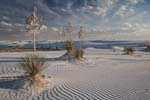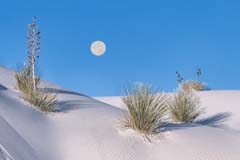White Sands National Park is the home of the world's largest gypsum dune field, nearly 275 sq. miles in area. White Sands is located in south-central New Mexico. It is about 3.5 hours from Albuquerque International Airport and less than two hours from El Paso International Airport. The nearest town is Alamogordo, NM, 14 miles northeast of the monument. Alamogordo has many motels and restaurants. There is no RV or car camping within White Sands Park boundaries. Backcountry camping is available at ten designated sites. Sites cannot be reserved in advance. All are available only on a first-come, first-served basis. Sites are between .7 and 1.1 miles from the backcountry camping parking lot. The backcountry camping lot is at 32.809658°, -106.263098°. It's the first parking lot on the left side of Loop Drive when driving it clockwise.
Important Safety Note - if you use a GPS for navigation, be aware that the nearby White Sands Missle Range occasionally does GPS interference testing. GPS may not be available or unreliable during these tests. Most of the testing is done in the wee hours of the morning. It's easy to get lost in the white dunes, especially on cloudy days. Before heading out, you should do a web search or check with a park ranger to determine if GPS testing is being done.
When to Go
Climate at White Sands is very similar to that of Alamogordo, shown here in the following graphs from weatherspark.com:
Overnight temperatures at White Sands in winter are often below freezing. Consider this if you choose to winter camp at the backcountry sites. There is little precipitation during winter, and dusk temperatures are pleasant. Summers at White Sands are hot, but hiking distances are short, and dramatic weather is possible. Visitation is high in summer, so you'll need to hike further out into the dune fields to avoid footprints. Winds peak in the Spring, so I wouldn't plan a long-distance trip to the monument then. If you live in the southwest, Spring can be a good time to visit. Just pick a day when the winds aren't blowing. The many yuccas in White Sands bloom in April. If you wish to shoot these, call the visitor center in April to see if they're flowering. I suggest you avoid Spring Break and Easter weeks when the park can be crowded. Alcohol is banned in the park from February through May, so Spring Break is no longer the problem it once was for the park. The best time to visit is late October / early November when the Cottonwoods are changing color. By mid-November, most of the Cottonwoods have changed color. In 2015, the Cottonwood outside the visitor center still had color on December 1st.
Hours of Operation
Like most landscapes, White Sands photographs best at sunrise and sunset or in the blue hour. Unfortunately, White Sands is closed between sunset and sunrise. White Sands opens at 7 a.m. every day of the year, usually 30 minutes to one hour after sunrise. This is too late for the best sunrise shots, considering the time to drive into the park and hike in. White Sands typically closes thirty minutes to one hour after sunset, so late-day photography is usually possible, provided you do not hike too far into the dune fields. Here is a schedule of 2020 closing times:
White Sands Hours of Operation
Dunes Drive opens at 7:00 a.m. daily except when there is a park closure.
| Dates: | Visitors Must Exit Before: |
| January 1 – February 1 | 6:00 p.m. |
| February 2 – March 7 | 7:00 p.m. |
| March 8 - April 11 | 8:00 p.m. |
| April 12 – May 23 | 8:30 p.m. |
| May 24 – September 12 | 9:00 p.m. |
| September 13 – October 31 | 8:00 p.m. |
| November 1 – December 24 | 6:00 p.m. |
| **December 25** | CLOSED |
| December 26 – December 31 | 6:00 p.m. |
It is possible to extend your shooting time in one of two ways: stay at one of the backcountry campsites or use the White Sands early entry/stay late program. This program lets you and your party enter before opening or stay past closing time. The fee is $50 per hour per group. Your group can consist of up to four vehicles. If you wish to enter early or stay late, you need to apply at least a week in advance; see the White Sands website for more information and an entry form.
As of January 2024, the backcountry campsite area is closed for rehabilitation. There has yet to be an estimated date for reopening. Backcountry camping requires a hike with gear of about one mile. Site numbers are hard to find in the dark, even with a flashlight, so I suggest you hike in during daylight hours. Ten sites are available, first-come, first-served. Winters are cold, summers are sweltering, and thunderstorms are likely. It can be windy during the spring, so for comfortable camping, that leaves only the fall.
Shooting Tips
Expose to the Right - When shooting, increase your exposure as much as possible while avoiding blown out highlights. Exposing to the right maximizes the amount of light striking the sensor and improves the technical quality of your images. In practice, "Expose to the Right" means reviewing the histogram after shooting and adjusting the aperture, ISO, or shutter speed accordingly. The histogram should reach the right edge of the chart. If it doesn't, increase the exposure until it does. Normally, after exposing to the right, you need to darken the image in post to increase contrast or saturation to get a more natural-looking image. This adjustment is unnecessary for White Sands NM images since you want the sand to look as white as possible while retaining detail.
Low dunes often produce the best shots - Lower dunes often present interesting lines and curves and allow for more varied compositions than higher dunes do. The highest dunes in White Sands are in the western end of the park, off Loop Drive. In this area, there is very little vegetation. When shooting the western end, use sand ripples or animal tracks as foreground, dune edges as leading lines, and S curves. When shooting the lower dunes, include some foreground in the composition. Yuccas, grasses, and their shadows make excellent foregrounds.
Simplify - My favorite images are often of a single cluster of grass or a single yucca. Unfortunately, yuccas and grasses usually cluster in groups, resulting in busy compositions. The area on Dunes Drive where the pavement ends is the rough boundary between too much vegetation and the high dunes area. It is a good place to begin looking for simpler compositions.
Shoot some compressed landscapes - Include a long lens in your bag when you shoot the high dunes at the western end of the park. A zoom of 200 - 300mm at the long end works well.
Shoot in the Blue - The blue hour is the half-hour before sunrise or after sunset. I've missed many good shots by quitting as soon as the sun went down. During the blue hour, shadows are softer, resulting in subtler pictures than those made in the sometimes harsh light of the desert. Color in the sky and reflected color on the dunes can be present for as long as 45 minutes after sunset. If you shoot in the blue, you'll probably need an early entry / stay-late permit.
Cottonwoods and Fall Color - Fall color normally peaks in early November. The yellow/orange complements the blue skies and is a very effective color combination. A little color in the monochromatic White Sands environment goes a long way.
Shoot the dunes lit by a full moon - Ranger-led Full moon hikes are available during much of the year on days with a Full Moon. There is something magical about seeing the white dunes under a full moon. Consider light painting a single yucca, sand ripples, or an animal track when the moon isn't full.
Avoid footprints - if possible. Hike further into the dune field or shoot at dawn after the night winds (when strong) have erased the prints of the prior day. If you cannot avoid footprints, they can be effectively removed in post using Photoshop's Content-Aware Delete or Remove tools.
In post - bring out the detail and contrast of the sand ripples. NIK Software's Color Effects Pro is very good at this; use the Detail Extractor tool.
Photograph a Camel - If you happen to be at White Sands on a Sunday afternoon, look for preacher George Stone and his four-year-old (as of 2019) camel Samson on the dunes.
Park Map
Below is the official White Sands map in various georeferenced formats. There are a few small pullouts on the first four miles of the park road but nom parking lots. The first open parking area is the "Interdune Boardwalk" parking area.
| GeoPDF | GeoTiff | Oruxmaps | KMZ |
| White Sands | GeoTiff | Oruxmap | KMZ |
Google Map of the area

To view the map at high resolution in Google Maps please click anywhere on the map above.

























